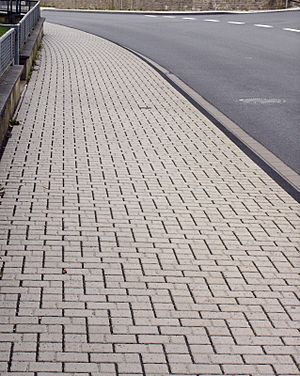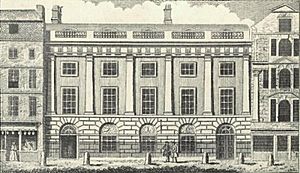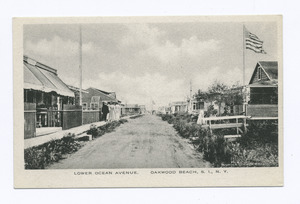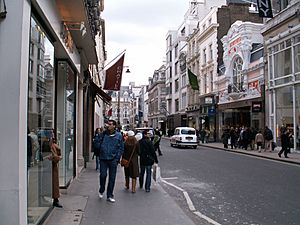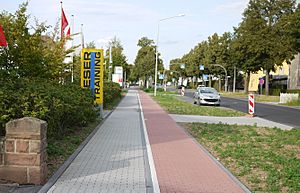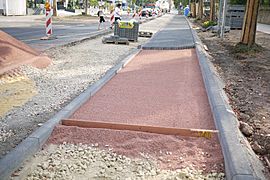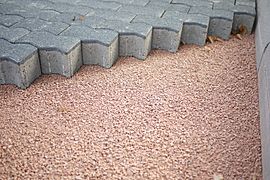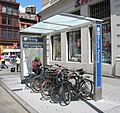Sidewalk facts for kids
A sidewalk is a special path for people to walk on. It usually runs next to a road. In some places, like the United States and Canada, it's called a sidewalk. In the United Kingdom, people often call it a pavement. In countries like Australia and India, it's known as a footpath.
Sidewalks help keep people safe. They separate walkers from cars and other vehicles on the road. Sidewalks can be made from different materials, like concrete, bricks, or asphalt.
Contents
The History of Sidewalks
People have been using sidewalks for a very long time, over 4,000 years! The ancient Greek city of Corinth had sidewalks by the 4th century BCE. The Romans also built paths for walkers, which they called sēmitae.
However, during the Middle Ages, roads became narrow. People and wagons often shared the same space, which was not very safe.
After the Great Fire of London in 1666, people started to make the city more organized. In 1671, new rules were made to pave streets for walkers with cobblestones. Large stone posts called bollards were also put in place. These bollards helped protect people from traffic in the middle of the road.
In the 1700s, the British government passed laws to improve sidewalks. A law in 1766 allowed the City of London to build foot-ways (sidewalks) on all streets. These sidewalks were raised above the street level with curbs to separate them from the road. By the late 1800s, big, wide sidewalks were common in major European cities. They were seen as a sign of a modern city.
Why Sidewalks Are Important
Helping People Travel Safely
Sidewalks are a very important part of how people get around. They give a safe place for people to walk, away from cars and trucks. This helps prevent accidents. Most roads have two sidewalks, one on each side, with the middle part for vehicles.
In the countryside, you might not see many sidewalks. This is because there isn't as much traffic, either from people walking or from cars. But in towns and cities, sidewalks are very common. In busy city centers, there might be more people walking than cars driving. In these areas, sidewalks can be very wide, or sometimes the whole street is just for people walking.
Good for the Environment
Sidewalks can also help the environment. When people have safe places to walk, they might choose to walk instead of drive. This means fewer cars on the road, which can help reduce air pollution and carbon dioxide. One study found that having sidewalks could reduce car travel by 6 to 8 percent.
Making Roads Safer
Research has shown that sidewalks make roads much safer. A study in Florida found that adding sidewalks could reduce crashes by about 74 percent. Another study found that the chance of a car hitting a person walking was 88.2 percent lower on roads with sidewalks. This shows how much sidewalks help keep walkers safe.
The speed limit on a road also affects safety. Higher speed limits mean a greater risk of crashes. Sidewalks can encourage drivers to go slower, making the area safer for everyone.
Sometimes, in very cold weather, sidewalks can get covered in "black ice." This ice is thin and clear, making it very hard to see. It can cause people to slip and fall.
Riding bicycles on sidewalks is often discouraged. Some studies show it can be more dangerous than riding in the street. This is because cyclists might crash into people walking, or they might have accidents with cars when crossing streets or driveways. It's especially risky to ride a bike on a sidewalk against the direction of traffic.
Benefits for Your Health
People who live in neighborhoods with sidewalks are more likely to walk. Walking is a great way to stay healthy! It can help prevent heart disease and obesity. Children who walk to school often have better focus and concentration in class.
Social Uses of Sidewalks
Sidewalks are not just for walking. They can also be lively social spaces. You might see outdoor cafes, small markets, or musicians playing music (called busking). Sidewalks are also sometimes used for parking different vehicles like cars, motorbikes, and bicycles.
How Sidewalks Are Built
Today, sidewalks in North America are often made of concrete. In Europe, you might see more sidewalks made of tarmac, asphalt, brick, or stone. The materials used can affect how good they are for the environment. For example, using certain types of stone can be better than materials made from oil.
Wooden Sidewalks
In the 1800s and early 1900s, some places in North America had sidewalks made of wood. You can still find these today, especially at historic beach areas. They are often called boardwalks. They help protect the ground underneath.
Brick Sidewalks
Brick sidewalks are found in some cities. They often look very nice. When building with bricks, workers usually use a special vibrating machine. This machine helps lock the bricks tightly into place after they are laid down.
Stone Sidewalks
Sometimes, large flat pieces of stone called flagstones are used for sidewalks. This is often done in old town centers where people want a beautiful look. Other times, sidewalks are made from pre-made concrete slabs that look like stone.
Concrete Sidewalks
In the United States and Canada, most sidewalks are made from poured concrete. You can still find concrete sidewalks from the 1860s that are in good condition! When Portland cement was first brought to the U.S. in the 1880s, it was mainly used for building sidewalks.
Today, most concrete sidewalks have lines or grooves cut into them every few feet. These lines help prevent the concrete from cracking when the temperature changes or if the ground moves. Even with these lines, very cold weather or tree roots can still cause damage over time.
In places with very cold winters, concrete blocks are sometimes separated by "expansion joints." These joints allow the concrete to expand and shrink with temperature changes without breaking.
Tarmac and Asphalt Sidewalks
In the United Kingdom, Australia, and France, sidewalks in suburban areas are often made of tarmac. In busy city areas, sidewalks are more commonly made of stone slabs, or bricks. The choice of material often depends on the look of the surrounding buildings and street design.
Images for kids
-
A sidewalk in Tampere, Finland.
-
A sidewalk being cleaned during a street clean-up in New York City.
-
A sidewalk in Tapie, Taiwan, with a special lane for bicycles.
-
An old sidewalk with a granite curb in Kutná Hora, Czech Republic.
-
A sidewalk in Wasaga Beach, Ontario, Canada, cleared after a snowfall.
-
A sidewalk market in Speightstown, Barbados.
-
Cars parked on a sidewalk in Moscow, Russia.
-
A sidewalk with trees in Oak Park, Illinois.
-
A sidewalk blocked by motorcycles in Iran.
-
A sidewalk in Nishapur, near the Mausoleum of Omar Khayyam.
-
A sidewalk in Benoni, South Africa.
-
A sidewalk in Omagh, Northern Ireland, UK.
-
"Sidewalk closed" sign in Miami Beach.
-
A sidewalk in Belleair Bluffs, FL.
-
A sidewalk in Montreal, Quebec.
See also
 In Spanish: Acera para niños
In Spanish: Acera para niños


